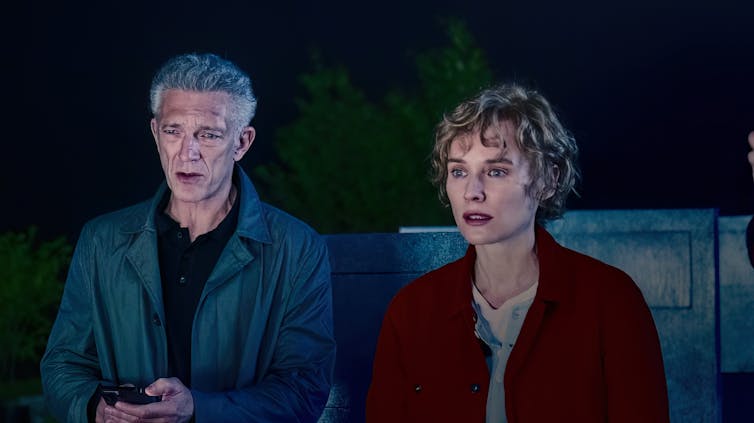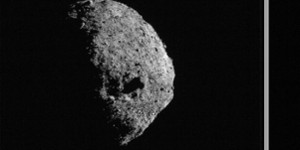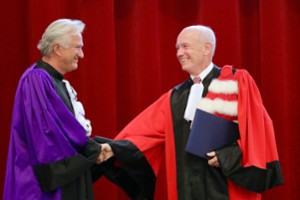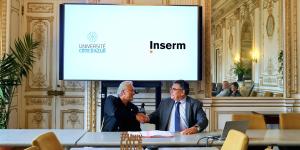
Director David Cronenberg returns to cinemas on April 30, 2025 with a new feature, Les Linceuls, starring Diane Kruger and Vincent Cassel. Will this 23ᵉ film stand out from the rest of his oeuvre? So far, his work has been marked by a recurring narrative pattern. Analysis.
A master of metamorphosis and bodily drift, David Cronenberg has sculpted a body of work as disturbing as it is influential, redefining the boundaries of horror cinema. While his filmography is widely recognized for its thematic coherence and aesthetic diversity, few writers have emphasized its astonishing narrative homogeneity.
Of David Cronenberg's 22 feature films released to date, 19 share an almost identical structure (the other three being The Brood, Fast Company and the latest Crimes of The Future). Videodrome (1983) is, in this sense, an interesting case, as its structure can serve as a matrix example for all Cronenberg's other works.
Videodrome, a perfect example of the common thread
In Videodrome, we follow the story of Max, the director of a pornographic chain. He forms a relationship with Nicki, a young woman with whom he experiments with a sexuality new to him. He also discovers a new program, Videodrome, which unwittingly exposes him to a video signal capable of transforming his body. Investigating the program and its symptoms, he finds himself in the middle of a conflict between two groups: the "new flesh", led by Professor O'Blivion and his daughter Bianca; and Videodrome, led by Barry Convex and his accomplice Harlan.
After many twists and turns and transformations of his body, Max finally isolates himself in a shipwreck, where Nicki sends him a message telling him that he can access the "new flesh" if he agrees to commit suicide, which he does. The film concludes here, but in another version of the script, an additional scene was planned in which Max, Bianca and Nicki find themselves in the setting of the Videodrome program with multiple mutations, to have a sexual relationship of a new kind.
Following the idea of a single narrative thread at the origin of all Cronenberg's films, each work would then be a variant of this thread, incorporating either all of its narrative elements, or just a part of them. Videodrome is of particular interest because it is, in my opinion, the film that comes closest to this original narrative framework.
It tells the story of a childless man who, at one time or another, becomes involved in a relationship of seduction. He encounters a male figure with knowledge of the body (often a doctor, but not always). This knowledge is transmitted to him symbolically via an intermediary, who may be an object, a creature, knowledge or even an idea. This knowledge then modifies the hero's body, literally in the first third of Cronenberg's work, or symbolically in later films. With the help of his new body, the hero tries to reach an unprecedented stage of evolution, where a new type of sexual relationship is possible, allowing for total fusion. The situation inevitably turns sour, usually resulting in the hero's death or, at the very least, a deeply tragic ending.
This same narrative structure is at the root of all Cronenberg's stories.
Mondays to Fridays + Sundays, get free analysis and decryption from our experts for a different take on current affairs. Subscribe today!
For example, in Cosmopolis, the character of Eric sees his symbolic body, embodied by his car, transformed from the moment a doctor diagnoses him with an asymmetrical prostate. This unbearable imperfection, on which the doctor refuses to do anything, leads to the character's moral and physical collapse, culminating in his confrontation with his murderer, who also confesses to having an asymmetrical prostate. He thus joins Cronenberg's recurring category of "enemy brothers".
The archetypal figure of the knower as both positive and negative symbolic father, embodied by the characters of O'Blivion and Convex in Videodrome, is also particularly well represented in Scanners. In this 1981 feature, the doctor who helps the hero turns out to be the mad scientist who created his illness. He is also the father of both the hero and the main antagonist. Here we see how the figure of the knower is split between a protective father (perceived as such by the hero) and a predatory father (perceived as such by the hero's enemy brother).
Lacan with Cronenberg
The psychoanalyst Jacques Lacan proposed a number of concepts that may be useful in giving coherence to Cronenberg's work.
His characters' quest for fusion can be likened to Lacan's "impossible sexual relationship". The latter explains that there is a universal anguish due to the impossibility of merging with the other: the mathematical ratio 1+1 never makes 1. Cronenberg's bodily transformations are therefore attempts to circumvent this impossibility by creating a new body that enables access to a total jouissance that is not limited by any impossibility.
Another Lacanian concept can help us better understand these mutations: the symbolic body. This is the part of the body that is homogeneous with a language whose unit is the signifier. Cronenberg explains, for example, that in Videodrome, the gun that merges with the hand is the on-screen representation of a play on words: the signifier "handgun" becomes a fist-gun in the film. For Cronenberg, playing with words means playing with the body. David Roche made this point with his film Shivers (1975), in which he identified the creature as a signifier emerging from the mouth.
Taking Videodrome with these ideas, the film tells the story of a man whose symbolic body is transformed by a signifier embodied in the film by the " Videodrome signal". These transformations enable him to develop new sexual organs (the fist-weapon signifier is assimilated to the phallus signifier), enabling him to achieve sexual intercourse in Lacan's sense, and thus achieve fusion with his partners.
But the impossible cannot be shown, and for Cronenberg, it seems stronger to leave the viewer facing a black screen to confront his or her own relationship with anguish. We find the same idea very literally at the end of The Fly (1986), where the character attempts to physically merge with his pregnant wife, but fails in extremis.
Return of the primitive horde
If we stay within the field of Lacanian psychoanalysis, we can interpret the common narrative framework as a kind of remake of the Freudian myth of the primitive horde. Freud tells us that, at the dawn of time, there was a father who possessed all women, because he possessed a particular signifier: the phallus. Eventually, the father's sons had had enough. They killed him, then ate him, to take possession of the phallus. But to ensure that the father's hegemony did not recur, and that everyone submitted to a common law, they erected a statue in his name. Lacan returns to this myth, pointing out that, behind the father's alleged power, lies above all the sons' belief in that power.
This question of belief is predominant in Cronenberg's characters, who seem to adhere with great conviction to the father's knowledge, against all odds. They throw themselves wholeheartedly into their quest for fusion, to systematically tragic ends.
The only possible way out for the Cronenbergian hero seems to be to renounce fusion, and thus the total enjoyment it might allow. But only one will make this choice and thus avoid a tragic end. This is Joey/Tom in A History of Violence (2005), who chooses to renounce all enjoyment of "Joey", symbolically washing his hands of it in order to regain the life of "Tom". It's worth noting that he's also the only Cronenberg character to have children(The Brood (1979) is, for me, in a class of its own). Cronenberg seems to believe that only fatherhood can compete with the fantasy of total enjoyment for these characters.![]()
Maxime Parola, Doctoral student in Art at CTELA (Université Côte d'Azur)
This article is republished from The Conversation under Creative Commons license. Read theoriginal article.
THE CONVERSATION
Université Côte d'Azur, through its Science and Society department, joined "The Conversation" online news media in January 2022. The aim is to showcase the work of our research teams in the service of informed, reliable information that contributes to civic debate.
The Conversation is an online medium and a non-profit association. Its model of collaboration between experts and journalists is unique: to share knowledge, making the voice of researchers heard in civic debate, and enlightening the news with reliable, research-based expertise.
theconversation.com
SUBSCRIBE NOW!
To keep up with The Conversation experts on a daily basis, subscribe to our newsletter.
theconversation.com/en/new




